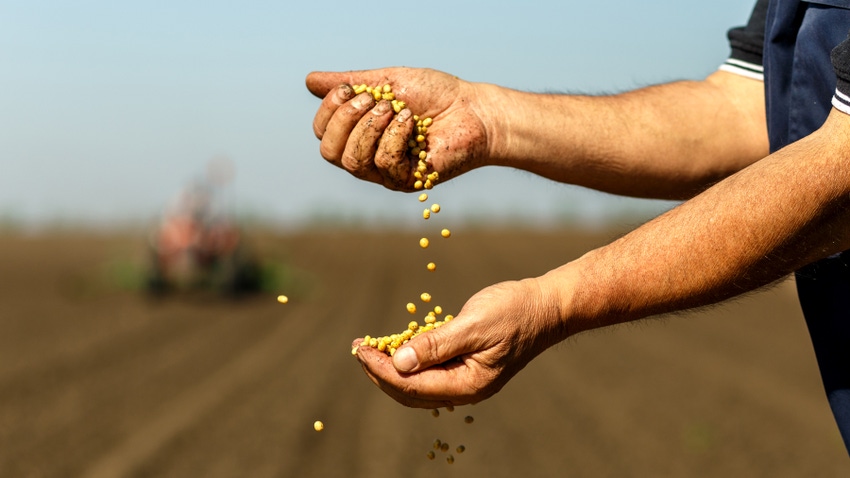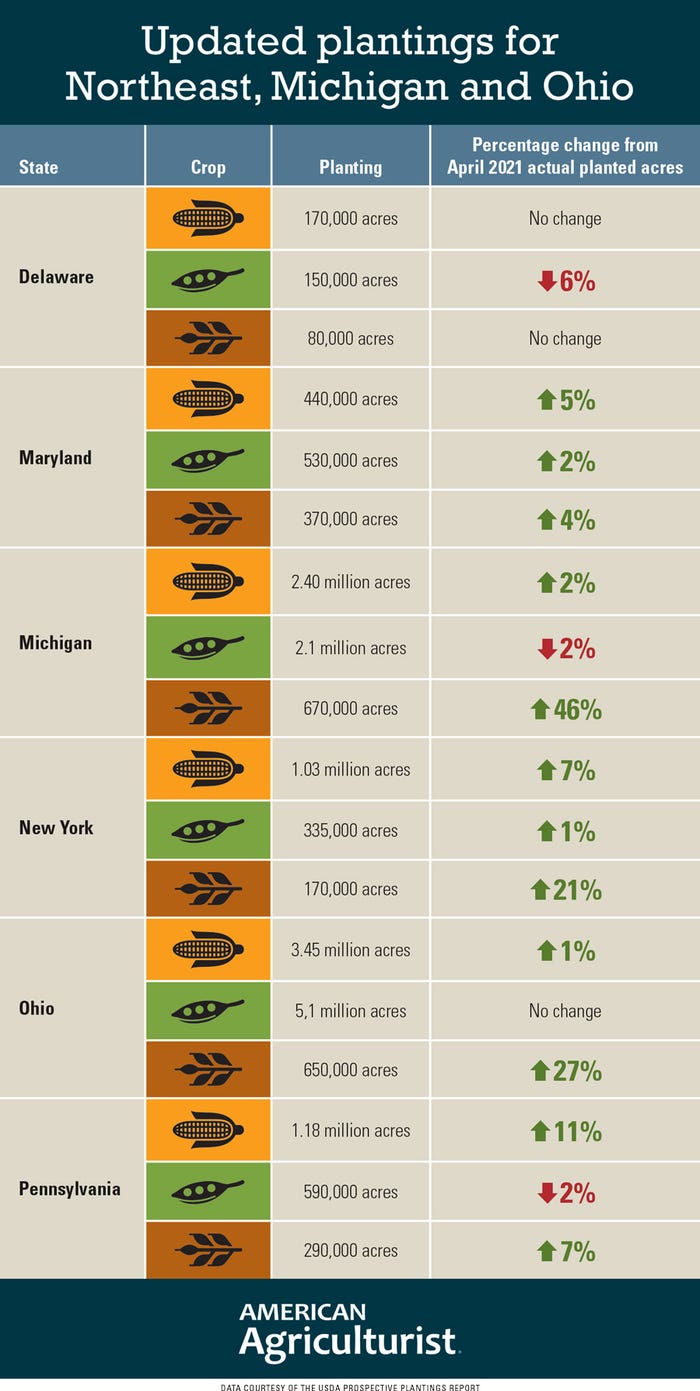
Corn is still king in most Northeast states and Michigan, but New York and Ohio growers are expected to plant their largest soybean crops ever, according to USDA.
Check out the graphic below to see the number of corn, soybean and wheat acres in your state:

Ohio growers are expected to plant 5.10 million acres of soybeans, by far the most in the region. Michigan growers are expected to plant 2.1 million acres of soybeans, down 7% from last season.
Corn acreage is expected to increase 11% in Pennsylvania — with Keystone State growers expecting to plant 1.18 million acres, the most in the Mid-Atlantic and Northeast. New York growers are expecting to plant 1.03 million corn acres, up 7% from last year.
Ohio growers will be planting 3.45 million acres of corn, up 1% from last year. Michigan growers are expecting to plant 2.40 million acres of corn, up 2% from last year.
Some soybean acres are coming out of rotation in Pennsylvania with 590,000 acres going into the ground, down 2% from last year. New York growers are expecting to plant 355,000 acres of soybeans, the largest ever and up 1% from last year.
Winter wheat acres are up significantly across the region. Michigan growers planted 670,000 acres of winter wheat, the most in the region and up 46% from last year. Ohio growers planted 650,000 acres of winter wheat, up 27%.
Maryland growers have planted 370,000 acres of winter wheat, up 4% from last year, the most in the mid-Atlantic and Northeast. Pennsylvania growers planted 290,000 acres of winter wheat, up 7%. And even though New York’s more northern climate makes it more challenging to get winter wheat acres in the ground in fall, growers reported planting 170,000 acres, up 21%.
National view
Corn won out in the total acres race this year as growers reported their intention to plant 92 million acres, up 4% from last year. Soybean acres will total 87.5 million acres, up slightly from last year.
The winter wheat acreage, at 37.5 million acres, is the highest since 2015, according to USDA’s Prospective Plantings report, as growers are hoping to capitalize on strong prices.
In a March 31 article in Farm Futures, sister publication to American Agriculturist, Jacqueline Holland, Farm Futures grain market analyst, said USDA surprised most market analysts who expected less overall corn acres.
“Obviously, this report differed substantially from our March 2023 Farm Futures survey estimates,” she said. “In truth, I was a little shocked by just how far we missed the mark. But I’d be naïve to pretend like I didn’t expect it could be a possibility. Crop budgets for corn production are still very lucrative, and falling nitrogen prices are helping to keep corn acres slightly more attractive than their soybean counterparts this spring.”
Here’s a complete list of prospective plantings for some of the other states across the region:
Corn
Connecticut, 25,000 acres, unchanged
Maine, 28,000 acres, down 3%
Massachusetts, 14,000 acres, unchanged
New Jersey, 85,000 acres, up 12%
Vermont, 90,000 acres, up 2%
Soybeans
Delaware, 150,000 acres, down 6%
New Jersey, 100,000 acres, down 9%
Hay
Connecticut, 53,000 acres, up 2%
Delaware, 11,000 acres, unchanged
Maine 140,000 acres, up 4%
Maryland, 220,000 acres, up 2%
Massachusetts, 60,000 acres, unchanged
Michigan, 800,000 acres, up 1%
New Jersey, 95,000 acres, down 13%
New York, 1.31 million acres, up 6%
Ohio, 820,000 acres, down 1%
Pennsylvania, 1.36 million acres, up 1%
Vermont, 175,000 acres, up 6%
Barley
Delaware, 21,000 acres, no change
Maine, 11,000 acres, no change
Maryland, 34,000 acres, up 21%
New York, 9,000 acres, unchanged
Pennsylvania, 37,000 acres, down 10%
Oats
Maine, 26,000 acres, unchanged
Michigan, 60,000 acres, up 20%
New York, 80,000 acres, up 18%
Ohio, 30,000 acres, down 40%
Pennsylvania, 78,000 acres, down 10%
Wheat
Delaware, 80,000 acres, no change
New Jersey, 30,000 acres, up 15%
About the Author(s)
You May Also Like






